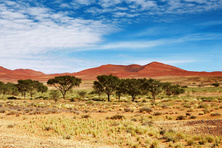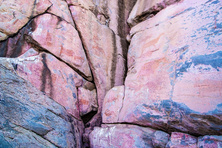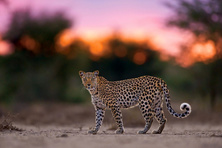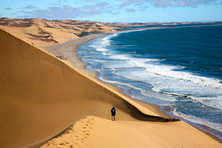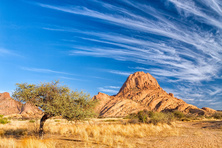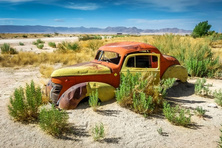Namibia
- Currency: Namibian dollar
- Time: UTC+2, summer UTC+1
- Languages: English, German, Ovambo, Afrikaans, Dammara, Guerrero
- Religions: Christian (Evangelical Lutheran Church in Namibia, Catholicism)
- Sections: Get in Visa Customs Cuisine Money Details of interest Popular resorts
Namibia is a country in South-West Africa. Its neighbouring countries are Angola, South Africa, and Zambia. The western coast is washed by the waters of the Atlantic Ocean. The capital city of Namibia is Windhoek.
There are two climatic zones in Namibia. The wider part of the country has a dry tropical climate and the north-western part has a subtropical climate. The best time for visiting Namibia is during a dry period without monsoon rains from May to October.
The Namibians are mostly the Christians, however, many people do not want to lose their connections with the ancestors and practice traditional beliefs. The official languages are English, German, Ovambo, Afrikaans, Dammara, and Guerrero.
It seems that Namibia was created for out-of-town tourism. The tourists will enjoy with African nature, visit unique Namibian reserves and national parks. The Etosha National Park and the Northern region of the country will amaze you with its rich fauna. It is a habitat for mammals, snakes, and birds. In the parks, there are all the conditions for watching the birds in the natural habitat and photographing them.
In the Walvis Bay, the tourists can see the whales. In Otjiwarongo, there is Cheetah Conservation Fund, a sheepdog kennel, and Otjiwarongo Crocodile Farm with the population of Nile crocodiles. If you are looking for adventure, visit the Mundulea Nature Reserve and stay for a night in the camping. You can also take a safari trip.
The best place for surfing, windsurfing, and kitesurfing is Swakopmund. The climbers usually choose Spitzkoppe.
Those who prefer city entertainments should stay in Windhoek. There you can learn about the history and the culture of the country, visit museums and take part in festivals and carnivals. Celebrations, events, and festivals are held here throughout the year.
Get in
The easiest way to get to Namibia is a flight.
By Plane
The CIS tourist can make a transfer in the hub airports in Frankfurt, London or Munich.
By Bus
One can combine his or her journey to South Africa with a trip to Namibia. There is a regular bus running between these two countries. However, due to heat the travel can be very tiresome.
Visa
The CIS and EU travellers do not need a visa to travel to Namibia provided they stay in the country will not exceed 90 days.
The tourists must provide:
- an international passport valid for, at least, six months;
- migration card.
A stamp Visitors Entry Permit is put and the aim of the visit is indicated. There are no additional charges for the tourists.
The Namibian law restricts the movements of the tourists in the areas owned by the diamond mining company De Beers and also in some reserves and national parks. A famous Skeleton Coast is an acknowledged national park with a restricted fee-paying access.
Customs
The Customs legislation of Namibia does not restrict the import and export of currency. The export of national currency is limited to 50.000 Namibian dollars.
The tourists are allowed to bring in a limited amount of the following things duty-free:
- tobacco and alcohol;
- perfume;
- gifts the cost of which must not exceed 50.000 Namibian dollars.
The tourists are not allowed to import canned meat.
It is prohibited to export:
- diamonds and minerals;
- hunting trophies.
Cuisine
Gastronomic tourism is Namibia is for those who love exotic combinations and tastes. The tourists can try not only traditional beef or mutton but exotic meat of ostrich, zebra, and antelope.
If you like substantial meat dishes, you should try Boboti (lamb pilaf), Pojkikos (savoury meat stew), Landjyager (dry-cured sausage with spices), chicken stew with peanut butter, and ostrich steak.
In Namibia, they make excellent beer Windhoek Lager and Tafel Lager. On Namibian markets, one can buy locally produced alcoholic drinks such as grape brandy Crystal-Kelleray, watermelon wine Mataka, and palm moonshine Ualende.
If you have a sweet tooth, treat yourself to fresh exotic fruits and locally produced chocolate Springer.
If you have guts and want to discover new tastes, you can try roasted locust or worms Omaungu. Less threatening exotic dish in Namibia is lion tenderloin with spices and crocodiles tail stewed with peanut butter.
Namibian cheeses have a very delicate taste. Due to the lack of vegetables the local chefs must be very inventive and that is why side dishes in Namibia are very unusual. For example, you can be served mashed or boiled root plants, millet porridge with herbs, and Nara melon which reminds gigantic cucumbers.
Money
The national currency is the Namibian dollar. There are 1 cent to 5 dollar coins and 5 to 200 dollar bank notes.
The Namibian dollar is pegged to the currency of South Africa (rand) and it is accepted everywhere in Namibia. The US dollars are accepted only in hotels.
The tourists can exchange the currency at banks or in exchange offices at the International airport. Be aware that it is almost impossible to exchange the national currency for dollars or Euros.
The tourists can pay with Visa, MasterCard, and Diners Club in hotels, restaurants, large malls, and gas-filling stations. In large touristic centres, the tourists will find the ATMs, but the sum for withdrawing the money is limited to 1.000 Namibian dollars.
One can cash traveller’s check at banks though the cash is not always available there.
For the last five years the criminal situation has gone worse. The number of attacks on foreign tourists and robberies has increased.
Details of interest
If you are in Namibia, you should definitely take part in the festivals. The capital city holds an annual Windhoek Carnival, in October you can visit a large-scale fair and exhibition Windhoek Show and the beer festival Octoberfest. If you stay in Swakopmund, participate in the carnival Quest which takes place in August.
Sightseeing in Namibia
Two unique places in Namibia are under UNESCO protection:
- The Namib Desert or the dune sea as it is sometimes called. This is one of the oldest deserts in the world (about 80 million years old). Every winter, around the small water basins in the desert gather various animals.
- The Twyfelfontein Valley is a unique place where more than 2.500 drawings have been found. The oldest drawings are 5.000 years old.
- We recommend the tourists see some other unique Namibian sights:
- Damaraland is an amazingly beautiful area where the mountains are in a harmonious unity with the valleys. The laccoliths Organ Pipe and Barnt Mountain are split by the tremendous roar of the waterfalls.
- Groothfontein is a small town, but it gained its popularity due to a meteor crater and the largest meteorite in the world Hoba. The scientists say that the meteorite which weights about 50 tonnes fell near Groothfontein about 80. 000 years ago.
- Keetmanshoop or the southern capital is a city which was founded in 1866. There is the National Monument Quiver Tree Forest. To the north-east away from Keetmanshoop, there is Giants Playground, a unique geological phenomenon which consists of giant stones naturally piled on top of each other.
Namibian Souvenirs
The tourists bring from Namibia unusual souvenirs. In souvenir shops, one can buy wooden sculptures and figurines, African masks, crafts from semi-precious stones and skins of zebras.
A funny souvenir is decorative buttons Ekipa made of ivory. In the past, the buttons were a symbol of prosperity and also served instead of money. In Namibia, they mine very beautiful gems: semi-precious stones and diamonds. In Windhoek and Swakopmund, there are many jewellery shops. Fashionistas can also buy ostrich leather accessories and shoes.
Another hallmark of Namibia is sheep wool carpets. The carpets are decorated with traditional national patterns and the images of birds, animals, and plants. The Namibians can also make a custom carpet.







